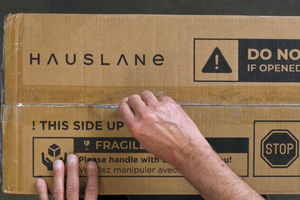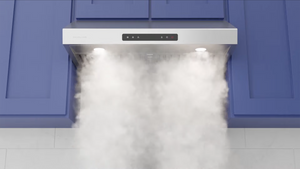Understanding Range Hood Blowers, their Power, and Noise Levels
The first range hood was invented 99 years ago, but they didn’t become a standard American appliance until the 1950s and 60s. That means some of your living relatives had to breathe in dangerous cooking fumes when they were kids. Of course, their doctors were on TV recommending their favorite cigarettes, so indoor air pollution wasn’t a top priority.
Today, homeowners are committed to healthy kitchen ventilation, and choosing the right range hood for your home means understanding a few key concepts.
You don’t have to become an expert by any means, but getting a basic understanding of blowers, CFM ratings, and the noise they produce will help you purchase a range hood that keeps your indoor air clean and makes your kitchen the ideal place to make savory meals.

What is a Range Hood Blower? (Sone vs. Decibels)
A range hood blower is a motor-driven fan that draws air from the stove and either pulls it out of the home or filters it and recirculates it. It all depends on the type of range hood.
Ducted range hoods expel the air outside the home through ducts, while ductless range hoods use a complex filtration system. In either case, the blower is a key component of the range hood. Without the blower, no air moves.
There are different types of blowers, from axial blowers to centrifugal blowers, but none of that really matters when it comes to buying a range hood. What matters to homeowners is the blower's power, efficiency, and the amount of noise it produces. All these things will impact your cooking experience and your quality of life.
Blower Power and CFM
A blower’s suction power is measured by the amount of air it moves through a given space over a given period of time. The metric for blower power in the United States is Cubic Feet per Minute (CFM), which is the amount of air that can pass through one cubic foot of space in one minute.
Now, it may be tempting to assume that the higher the suction power, the better the blower, but it’s not that simple. While more powerful blowers tend to make more noise, all things being equal, a number of factors influence noise. We’ll talk more about that below.
Another reason that higher CFM isn’t necessarily better is that more powerful blowers may require a makeup air filter to maintain air pressure in the home. Whether you need a makeup filter will depend on building codes in your city and state.
The bottom line is that you’ll want to purchase the ideal blower for your kitchen, and that’s related to the size and power of your stove. We’ll explain how to determine the minimum CFM rating for your stove below.
Noise and Sone Ratings
We’ve written an in-depth blog post about noise and sone ratings, but the important thing to understand is that the sone scale is used to determine how the human ear perceives a given noise level. Unlike decibels, which measure vibrations caused by sound, sone is a measurement of auditory perception.
The reason we have two different measurements is because the human ear perceives various frequencies and sounds differently, so a higher decibel sound might not necessarily feel louder to us. The sone score takes that into consideration. Here’s a quick guide to sone ranges for noise levels you might hear in your home.
Sone Range for Household Noise Levels:
1 sone: The sound of a refrigerator humming
2 sones: A quiet office or another professional environment
3 sones: A TV playing at a comfortable volume
4 sones: A typical conversation between two people
5 sones: A louder, more active conversation
6 sones: A quieter restaurant setting
7 sones: Light traffic
8 sones: The average sound of traffic
9 –10 sones: Congested traffic sounds

When shopping for a range hood, take a look at the sone level for different settings. Many powerful range hoods reach a level of 10 sones at their highest settings, although Hauslane uses the latest technology to run quieter at their max settings (around 8 sones or less).
Hauslane range hoods also feature variable power settings, which means you can lower the noise by lowering the power. This is a great option because you’ll have the high power available when you’re making a meal that produces a lot of smoke, and you can lower the speed as soon as you’re done.
What CFM Do You Need?
Now we’ll answer the million-dollar question: how much blower strength do you need for your stove? The minimum strength required to successfully clear cooking fumes from your kitchen depends on the type of stove you’re using (gas vs. electric) and the size of your range.
Electric Stoves
The calculation for electric stoves is simple. Lay a measuring tape across the width of your stove. In other words, when you face the stove, measure the total distance from the left-hand edge to the right-hand side. You’ll need 10 CFMs for every linear inch.
For example, if you measure the width of your stove at 36 inches, you’ll need a 360 CFM blower at the very minimum.
Gas Stoves
Gas stoves require a little research. The minimum CFM required for stoves is based on British Thermal Units (BTUs), which measure the speed at which water boils when the burner is at its maximum power.
Google the manufacturer’s guide for your stove to determine the BTU of each burner, or look for a tag on your stove. It should be located on the back of the unit, inside the unit, or under the hood. Add each burner's BTU together, then divide that number by 100 to determine the blower’s minimum CFM requirements.
For example, let’s say your range has the following BTUs for each burner:
Burner #1: 14,000 BTU
Burner #2: 14,000 BTU
Burner #3: 8,000 BTU
Burner #4: 8,000 BTU
Add the BTUs: 14,000 + 14,000 + 8,000 + 8,000 = 44,000 total BTU
Divide the total by 100: 44,000 BTU ÷ 100 = 440
Minimum CFM requirement for your gas stove: 440 CFM

Getting the Best of Both Worlds
As we mentioned earlier, stronger blowers (i.e., blowers with higher CFMs) tend to be louder, all things being equal. The good news is that all things are never equal in the world of range hoods because there are other ways to mute the sounds produced by a blower.
In other words, you don’t necessarily have to sacrifice power for noise reduction. Here are four factors that affect the noise volume of your blower: technology, proper installation, ductwork, and regular maintenance.
Range Hood Technology
The engineers who design modern range hoods have come up with amazing ways to muffle the noise produced by even the most powerful blowers. From fan design to the unit’s casing, state-of-the-art range hoods like the ones we sell at Hauslane are designed to reduce noise while maximizing performance.
Proper Installation
Proper range hood installation ensures that your unit works at its full capacity while minimizing noise. Poor installation, on the other hand, can impact both its effectiveness and its ability to minimize noise.
Ductwork
The type of ducts used to pump exhaust out of your home will impact the noise level. Flexible ducts have folds that absorb the sound, and the sound in under-the-cabinet units is muffled further by the cabinetry.
If you’re experiencing excess noise with your current blower, check out these tips to troubleshoot the issue.
Regular Maintenance
Maintaining your range hood is key to ensuring performance and keeping noise to a minimum. If you follow the proper inspection and maintenance steps, a quality range hood will reduce indoor air pollution for many years. If you notice excess noise despite regular maintenance, be sure to contact a qualified technician.
All Hauslane range hoods come with a limited lifetime warranty plan, along with a 2-year warranty on parts—so if your range hood is making excessive noise due to a manufacturer defect, let us know. It’s rare, since Hauslane range hoods are built with the utmost care and precision, but we’ve got your back if there’s an issue.
Shop Quiet Yet Powerful Range Hoods
From HAUSLANE








